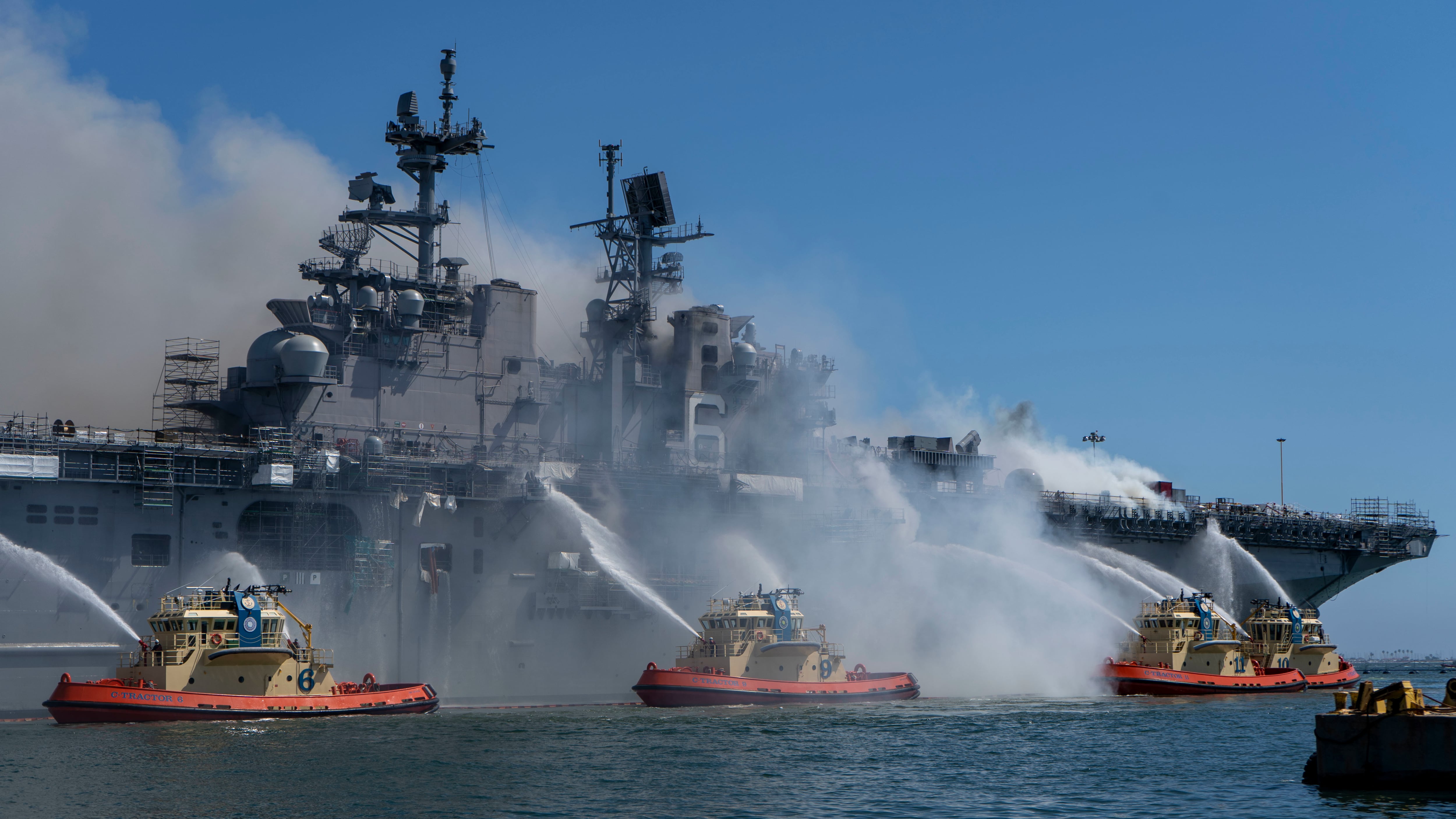WASHINGTON — The U.S. Navy is clarifying the chain of command for fires and other emergencies that occur while ships are in port for maintenance, the head of the surface navy said, after uncertainty about who was in charge contributed to ineffective firefighting efforts on former amphibious assault ship Bonhomme Richard.
Commander of Naval Surface Forces Vice Adm. Roy Kitchener told reporters the surface community is investing in fire safety, including paying for additional training and hiring more fire safety officers. One of the most prominent changes is clearly identifying which leader on the waterfront would take charge of the situation if a fire or other emergency arose.
That responsibility will now rest with Kitchener, in his role as commander of Naval Surface Force Pacific, and Rear Adm. Brendan McLane as the commander of Naval Surface Force Atlantic. Each admiral will identify an executive agent for each fleet concentration area under their command — Mayport, Fla., for example, or Everett, Wash. — who would execute that authority when the admiral is not physically present.
Navy spokesman Cmdr. Arlo Abrahamson told Defense News that the four-star admirals at U.S. Pacific Fleet, U.S. Fleet Forces Command and U.S. Naval Forces Europe-Africa jointly issues a naval message in April formally assigning SURFPAC and SURFLANT as the deputy primary commander for major fires, underneath those four-stars as the primary commander during an incident.
When the Bonhomme Richard caught fire on a Sunday morning in July 2020, the firefighting response got off to a slow start, making it difficult to contain the fire. The ship ultimately burned for five days, and the Navy determined it would have to scrap the ship.
Kitchener’s predecessor, retired Vice Adm. Rich Brown, who was in the role when the fire occurred, has told Defense News U.S. 3rd Fleet should have been more involved in the firefighting effort, according to his understanding of the chain of command described in a key fire safety document, but declined to take action that morning. Brown said he stepped in to fill a leadership void, but received a secretarial letter of censure on July 15 for his role in the fire.
Though the investigation into the Bonhomme Richard fire didn’t tackle the chain of command issue directly, a related Major Fires Review acknowledged there had been confusion and inconsistency in the past between the operational and administrative chains of command for ships in maintenance.
The April message eliminates any questions as to who has authority to coordinate the response to a major in-port fire.
“We’ve continued to work and formalize waterfront [command and control],” Kitchener told reporters Aug. 18. “The bottom line is the PACFLT commander is the overall authority; he delegates to me as the deputy primary commander to be in charge of any kind of major incident that happens on surface ships in any of our fleet concentration areas.”
He added the surface community will be running drills to ensure this new command and control structure is well understood.
Kitchener also said the ship maintenance community is working on rewriting parts of Naval Sea Systems Command’s fire prevention and response manual and will likely require the Navy to add more resources and safety features on the pier to support an emergency response.
Kitchener said he has conducted fire safety assessments on about 130 ships since he took command just weeks after the Bonhomme Richard fire and has found 24 discrepancies that needed fixing. The assessments may be no-notice walk-throughs, and sometimes he asks a duty station to conduct a fire drill for him to observe.
He said he has also conducted pulse surveys to get fleet feedback and has reinforced the ship captain’s authority to stop maintenance if he or she sees something that’s wrong or unsafe. Kitchener is also collecting data that looks across an entire repair yard, which could be working on four or five ships at once, noting he wants to see the cumulative risk in a way individual ship captains can’t.
Kitchener has imposed a damage control red line: if a ship in maintenance has to shut down certain systems that can detect and suppress fires, such that the ship is no longer in compliance with the fire prevention and response manual, Kitchener or McLane must approve a mitigation plan, and the ship must inform the admiral when the system is taken down and brought back online again.
“It’s an enduring campaign. We fundamentally changed the way we look at in-port firefighting,” Kitchener said. “It’s warfighting readiness, quite frankly: we cannot allow the Chinese to attrite our ships, and we can’t attrite our own ships.”
Megan Eckstein is the naval warfare reporter at Defense News. She has covered military news since 2009, with a focus on U.S. Navy and Marine Corps operations, acquisition programs and budgets. She has reported from four geographic fleets and is happiest when she’s filing stories from a ship. Megan is a University of Maryland alumna.




